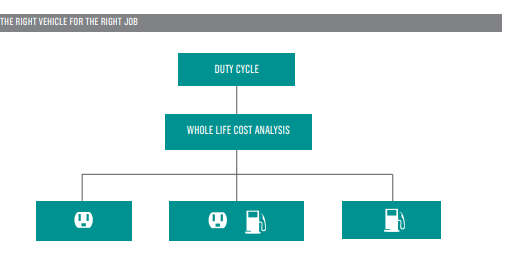Fleet management is the process of managing vehicles for an organisation to maximise efficiency and minimise costs. It requires long term planning to control the lifecycle of fleets from acquisition to disposal.
Roles in fleet management
Usually, fleet management is undertaken by a fleet manager. However, we are increasingly seeing sustainability managers involved in the process, as they look to reduce organisational carbon emissions by adopting electric vehicles in fleets. This requires two team members (likely unknown to each other) to work together, to manage electric vehicle fleet integration.
Therefore, it is important for sustainability managers to be well-researched as they engage with fleet managers. Understanding the technical language used by fleet managers is important, as is having a strong technical argument prepared for the discussion. Total cost of ownership is a central concept to fleet management and is particularly relevant to electric vehicles as their financial benefit is considered over whole of life costs.
There are more benefits to electric vehicles than the environment, and it is important to understand these when engaging with your organisation, your fleet manager, and other stakeholders.
How to effectively manage fleets
There are key activities required to effectively manage fleets.
1) Developing policy for vehicle fleet management
Fleet management policy will often include requirements for:
- vehicle eligibility
- allocation
- choice based on vehicle emissions
- safety standards
- methodology for costings
- fit for purpose
Policy is often tied to financial and taxation considerations, however; the environmental impact of fleets is increasingly having an impact on fleet policy as corporate social responsibility includes carbon reduction targets.
Policy is incredibly important in transitioning fleets to electric vehicles, as it can mandate their inclusion in vehicle purchasing preferences.
Fleet Management Organisation Custom Fleet has a guide to writing a fleet policy.
2) Determining fit for purpose vehicles
Fleets will often include a variety of vehicle types, that are used to perform specific tasks – this is called ‘fit for purpose’.
In determining whether electric vehicles can replace petrol or diesel vehicles in your fleet, it is important to consider what the vehicle will be used for. Understanding fit for purpose vehicles will enable you to choose the correct vehicle type and brand based on how staff will use the vehicle. Safety standards and emissions may also influence vehicle choice – as is often outlined in the organisation’s policy.
The fit for purpose considerations of electric vehicles additionally include charging locations and needs. The availability of charging infrastructure will have an effect on vehicle choice, as range and load capacity vary between vehicle to vehicle.
In Australia’s market it may not be appropriate to transition all fleet vehicles to electric vehicles yet, which is why it is necessary to have an operational plan and understanding of fleet fit for purpose requirements.

Source: The Climate Group [1]
3) Managing fleet utilisation
It is necessary to understand the usage of a vehicle to maximise whole fleet efficiency.
Usage includes:
- How a vehicle is used
- The number of kilometres it is driven
- Idle times
- Fuel economy
- Maintenance and repair costs.
Measuring vehicle utilisation enables a fleet manager to get the best use out of a vehicle at the lowest cost.
Telematics can be used to record vehicle utilisation. Additionally, fleet managers are now using telematics to capture driving techniques of staff. This includes braking and acceleration, understeer and oversteer.
Having knowledge of driving technique is useful for electric vehicles because they have regenerative braking – this converts lost kinetic energy from decelerating back into the battery pack. If regenerative braking is used effectively, it can help maximise an electric vehicle’s driving range.
4) Scheduling fleet servicing and maintenance
To ensure staff safety and keep fleet costs down, it is necessary to schedule and maintain vehicles in fleets according to original equipment manufacturer maintenance advice.
Understanding the requirements of a vehicle’s maintenance is important in the transition to electric vehicles. As noted in Charge Together Fleets, electric vehicles require less maintenance, and can therefore reduce fleet servicing costs. Maintenance scheduling is also necessary to ensure compliance and safety for staff.
5) Educating drivers on vehicle management
Electric vehicles drive differently to internal combustion engine vehicles. As such, staff should be trained on the use of an electric vehicle. This training should cover recharging, range and driving style.
When staff understand how to maximise a vehicle’s efficiency, this can have positive benefits on the fleet. Optimisation of the vehicle fleet will provide savings to the organisation.
Electric vehicles in fleets
Typically, fleet managers do not need to consider where fleet vehicles are refuelled, because petrol stations are ubiquitous. However, electric vehicles require charging infrastructure that is not yet readily available.
Therefore, there are new considerations for fleet managers when considering electric vehicles in regards to charging infrastructure. These include:
- the availability of public chargers
- the cost of installing
- the number of chargers needed for the fleet
- the current grid capacity
- hardware requirements
- software management
- reimbursement for staff.

